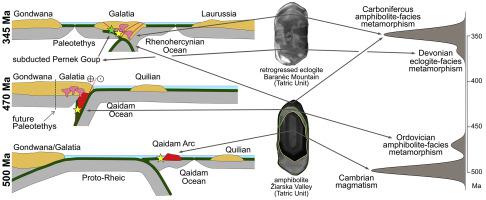Gondwana Research ( IF 7.2 ) Pub Date : 2020-12-24 , DOI: 10.1016/j.gr.2020.12.016 Jolanta Burda , Urs Klötzli , Jarosław Majka , David Chew , Qiu-Li Li , Yu Liu , Aleksandra Gawęda , Michael Wiedenbeck

|
Zircon petrochronology from amphibolites and retrogressed eclogites from the basement of the Western Tatra Mountains (Central Western Carpathians) reveals a complex rock evolution. An island-arc related basaltic amphibolite from Žiarska Valley shows three distinct zircon forming events: igneous zircon growth at ca. 498 Ma (Middle/Late Cambrian) and two phases of amphibolite-facies metamorphism at ca. 470 Ma (Early Ordovician) and at ca. 344 Ma (Early Carboniferous). A retrogressed eclogite from Baranèc Mountain records two zircon forming events: metamorphic zircon growth under eclogite-facies conditions at ca. 367 Ma (Late Devonian) and amphibolite-facies metamorphism at ca. 349 Ma (Early Carboniferous). These data contribute towards understanding and correlating major tectonothermal events that shaped the eastern margin of Gondwana in the Early Palaeozoic and its subsequent Variscan evolution. The metabasites record vestiges of two completely independent oceanic domains preserved within the Central Western Carpathians: (1) An Ediacaran to Cambrian oceanic arc related to the proto-Rheic - Qaidam oceans and metamorphosed to amphibolite-facies in the Early Ordovician subduction of the proto-Rheic - Qaidam arc during the Cenerian orogeny (ca. 470 Ma) and (2) Late Devonian oceanic crust related to a back-arc basin (Pernek-type), formed by the opening of the Paleotethys and metamorphosed to eclogite-facies during Devonian subduction (ca. 367 Ma). The common Variscan and later evolution of these oceanic remnants commenced with amphibolite-facies metamorphic overprinting in the Early Carboniferous (amphibolite: ca. 344 Ma; retrogressed eclogite: ca. 349 Ma) related to an Early Variscan consolidation and the formation of Pangea. None of the investigated rocks of the Central Western Carpathians show any evidence of being chronologically or palaeogeographically related to the Rheic Ocean, therefore any prolongation of the Rheic suture from the Sudetes into the Alpine-Carpathian realm is highly problematic. Instead, the Southern and Central Alpine Cenerian orogeny can be traced into the Central Western Carpathians.
中文翻译:

追溯原始流变-柴达木海洋遗迹进入西塔特拉山及其对中欧古生代古地理学的启示
来自西塔特拉山(中西部喀尔巴阡山脉)地下室的角闪石和后泻榴辉岩的锆石岩石年代学揭示了复杂的岩石演化。来自Žiarska谷的与岛弧有关的玄武质角闪石显示出三个不同的锆石形成事件:锆石火成岩在约3℃处生长。约498 Ma(中/晚寒武纪)和约2个角闪石相变质相。470 Ma(奥陶纪早期),大约在。344 Ma(石炭纪早期)。来自BaranècMountain的倒退的榴辉岩记录了两个锆石形成事件:大约在40℃的榴辉岩相条件下变质锆石的生长。367 Ma(晚泥盆世)和约2个角闪岩相变质作用。349 Ma(石炭纪早期)。这些数据有助于理解和关联构成古生代早期冈瓦纳东部边缘及其后续瓦里斯卡纳演化的主要构造热事件。这些变质岩记录了中西部喀尔巴阡山脉内保存的两个完全独立的海洋域的痕迹:(1)与原Rheic-Qaidam海洋有关的Ediacaran至Cambrian海洋弧,并在原始奥陶纪俯冲作用下变质为闪石相。 Rheic-在Cenerian造山运动(约470 Ma)期间的柴达木弧和(2)与后弧盆地(Pernek型)有关的晚泥盆纪大洋壳,是由古宙斯的打开形成的,并在泥盆纪变质为榴辉岩相俯冲(约367马)。这些海洋残余物的共同瓦里斯坎和后来的演化始于早石炭世(闪石:约344 Ma;后退榴辉岩:约349 Ma)的闪石岩相变质叠印,与早期瓦里斯坎固结和Pangea的形成有关。中西部喀尔巴阡山脉的任何经过调查的岩石均未显示出与拉西海在时间上或古地理上相关的任何证据,因此,将拉西缝线从苏台德群岛延长到高山-喀尔巴阡域的做法都存在很大问题。取而代之的是,南部和中部高山塞内尔造山运动可以追溯到中西部喀尔巴阡山脉。











































 京公网安备 11010802027423号
京公网安备 11010802027423号